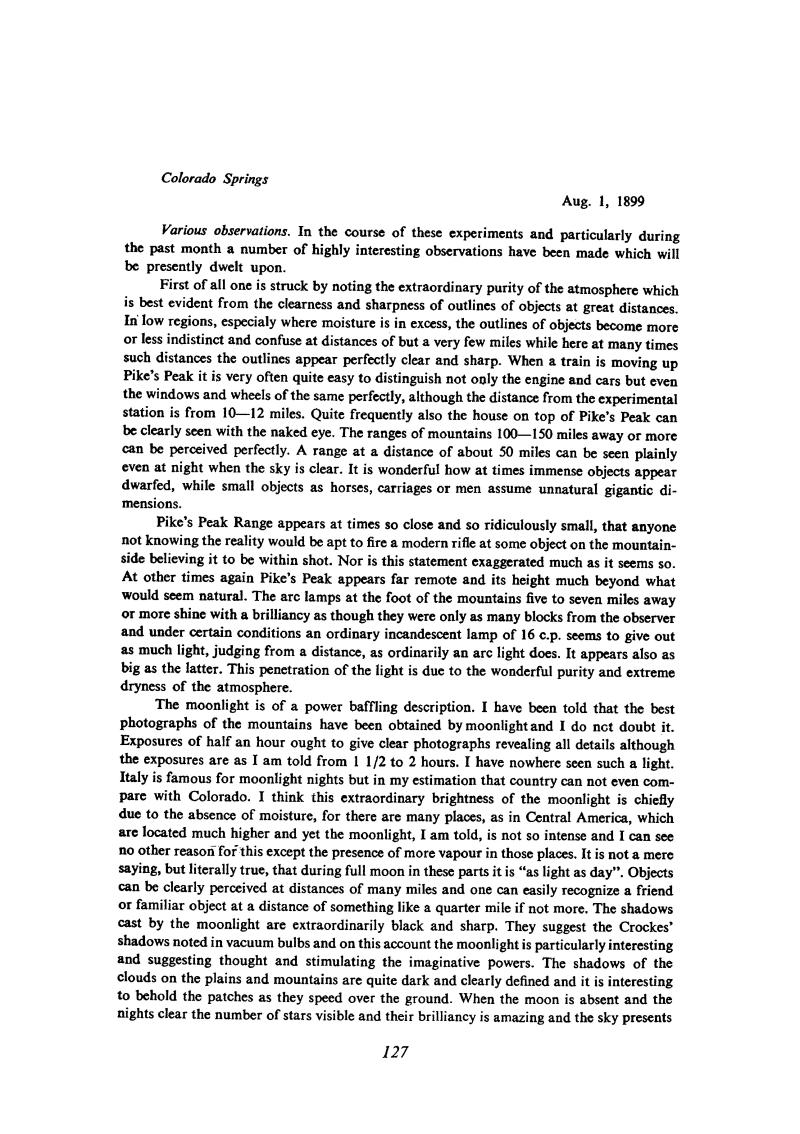
Nikola Tesla Books
Colorado Springs
Aug. 1, 1899
Various observations. In the course of these experiments and particularly during the past month a number of highly interesting observations have been made which will be presently dwelt upon.
First of all one is struck by noting the extraordinary purity of the atmosphere which is best evident from the clearness and sharpness of outlines of objects at great distances. In low regions, especially where moisture is in excess, the outlines of objects become more or less indistinct and confuse at distances of but a very few miles while here at many times such distances the outlines appear perfectly clear and sharp. When a train is moving up Pike's Peak it is very often quite easy to distinguish not only the engine and cars but even the windows and wheels of the same perfectly, although the distance from the experimental station is from 10 - 12 miles. Quite frequently also the house on top of Pike's Peak can be clearly seen with the naked eye. The ranges of mountains 100 - 150 miles away or more can be perceived perfectly. A range at a distance of about 50 miles can be seen plainly even at night when the sky is clear. It is wonderful how at times immense objects appear dwarfed, while small objects as horses, carriages or men assume unnatural gigantic dimensions.
Pike's Peak Range appears at times so close and so ridiculously small, that anyone not knowing the reality would be apt to fire a modern rifle at some object on the mountainside believing it to be within shot. Nor is this statement exaggerated much as it seems so. At other times again Pike's Peak appears far remote and its height much beyond what would seem natural. The arc lamps at the foot of the mountains five to seven miles away or more shine with a brilliancy as though they were only as many blocks from the observer and under certain conditions an ordinary incandescent lamp of 16 c.p. seems to give out as much light, judging from a distance, as ordinarily an arc light does. It appears also as big as the latter. This penetration of the light is due to the wonderful purity and extreme dryness of the atmosphere.
The moonlight is of a power baffling description. I have been told that the best photographs of the mountains have been obtained by moonlight and I do not doubt it. Exposures of half an hour ought to give clear photographs revealing all details although the exposures are as I am told from 1 1/2 to 2 hours. I have nowhere seen such a light. Italy is famous for moonlight nights but in my estimation that country can not even compare with Colorado. I think this extraordinary brightness of the moonlight is chiefly due to the absence of moisture, for there are many places, as in Central America, which are located much higher and yet the moonlight, I am told, is not so intense and I can see no other reason for this except the presence of more vapour in those places. It is not a mere saying, but literally true, that during full moon in these parts it is âas light as dayâ. Objects can be clearly perceived at distances of many miles and one can easily recognize a friend or familiar object at a distance of something like a quarter mile if not more. The shadows cast by the moonlight are extraordinarily black and sharp. They suggest the Crockes' shadows noted in vacuum bulbs and on this account the moonlight is particularly interesting and suggesting thought and stimulating the imaginative powers. The shadows of the clouds on the plains and mountains are quite dark and clearly defined and it is interesting to behold the patches as they speed over the ground. When the moon is absent and the nights clear the number of stars visible and their brilliancy is amazing and the sky presents
127
August 1
Extraordinary atmospherics in vicinity of laboratory instigated Tesla to devote some time to phenomena which are the consequence of a clean environment, dry air and low pressure. In such atmosphere sun and moonlight are more intensive than usual, the visibility is better, and even sounds propagate with less damping. The air is highly electrically charged, and according to Tesla that could be among other reasons, one of the reasons for this phenomena. Although the surrounding itself is not considered particularly attractive, Tesla is impressed with clouds, sunrise and sunset. His descriptions of these events are (literally - Editor) extraordinary, although they lack scientific preciseness and a systematical approach. This particularly pertains to descriptions of cloud types, and the description of some clouds' brightness which are brighter than the sun itself. Radiations, transformations of one kind of radiation to another and similar effects are known topics to Tesla and he uses his knowledge for the explanation of the events around him. In his considerations he grasped even the biological aspects of sun rays and atmosphere, and when he mentioned X-rays in connection with sun radiation, he expressed his hope that he will produce such intensity of these rays which will cure tuberculosis!

